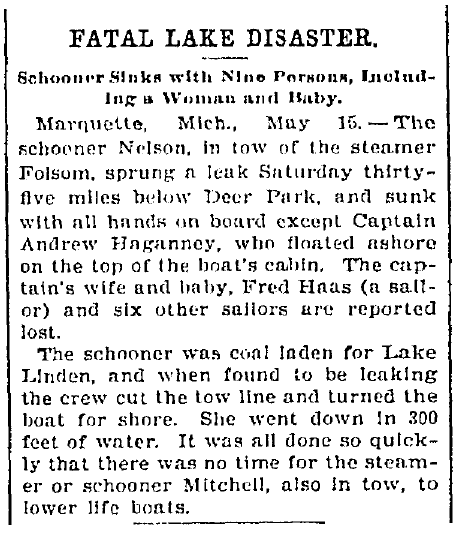Introduction: Duncan Kuehn is a professional genealogist with over eight years of client experience. She has worked on several well-known projects, such as “Who Do You Think You Are?” and researching President Barack Obama’s ancestry. In this blog post, Duncan searches old newspapers to learn more about Captain Hagney and the sinking of the schooner “Nelson” on Lake Superior in 1899, using various search tips to get good results.
Searching newspapers for an ancestor’s name that doesn’t seem to have a standard spelling can be a challenge for family historians. Here is an interesting case study about the captain of a sunken ship that may help you research those difficult ancestor names. Recently this ship, the schooner Nelson, was found under more than 200 feet of water in Lake Superior. There were several newspaper articles about the shipwreck discovery, but they had various spellings of the captain’s name – including “Haganey” and “Hagginey.”
The Story of the Sinking of the Nelson
The shipwreck story goes like this. On 15 May 1899, the schooner Nelson was overloaded with coal, in addition to the 10 people on board. There was a terrific storm on Lake Superior and ice accumulated on the ship, causing it to sit even lower in the water. The waves began to crash over the edges of the ship. The Nelson was being towed by the steamer A Folsom along with the Mary B Mitchell. At some point the towing line either broke or was cut. Shortly after, the Nelson tilted and the stern popped up out of the water as the entire vessel almost immediately went under. The captain placed his crew, his wife, and his toddler son into the lifeboat. Then he dove into the water to join them. Unfortunately, the lifeboat was still tethered to the Nelson and it was dragged down to the bottom of the lake by the sinking ship. The captain, who never reached the lifeboat, watched helplessly as his ship and family were lost. He clung to a piece of the wreckage and was found unconscious along the shore. The storm’s violent 50 mile-per-hour winds prevented any rescue efforts by the other two ships. Nine lives were lost; only the captain survived.
My Search for the Captain
This is a compelling story of a heroic effort by the captain of the Nelson that just wasn’t enough to save his family or crew, and I wanted to learn more details.
As always, I searched for contemporary records to find out more. I started by looking into GenealogyBank’s Historical Newspaper Archives. I ran this search:
I entered the name of the ship in quotation marks as a keyword. You do not necessarily need to use a person’s name to search on GenealogyBank – a keyword search is often effective. I also entered a date range from the date of the accident to several months after the event. When the search results came back I sorted the results with the oldest article first, as I prefer to read articles in chronological order.
I found many newspaper articles from all over the United States telling the story of the accident. Here are three of those articles.
This article refers to Captain “Haganney.”

This historical newspaper article refers to Captain “Hagney.”
This old news article also refers to Captain “Hagney.”
Using these old newspaper articles, I discovered that much of the information in the present-day articles about the discovery of the shipwreck reflected the information given in those 1899 articles. However, I found some inconsistencies as well. Perhaps most importantly, the old articles make no mention of the captain’s heroic effort to save his family and crew. A typical comment from those 1899 articles is that “The Nelson disappeared as suddenly as one could snuff a candle,” suggesting that the captain did not have time to do anything. I also find that Captain Haganey/Hagginey (as spelled in the modern newspaper articles) is spelled differently in the 1899 articles: “Haganney” and “Hagney.”
[search_box]
After learning about the shipwreck, I now wanted to know more about the captain himself – but there were so many spellings of his name I wasn’t sure which was correct. A quick search of census records on FamilySearch.org told me that he was the son of John and Mary Hagney from Oswego, New York. He also had siblings: Ellen, Thomas, William, and Mary.
Going back to GenealogyBank’s Historical Newspaper Archives, I narrowed my search using the name as it appeared in the census: “Hagney.” This search turned up several articles that told me a great deal about the captain.
One of the first I found was this very sad newspaper article. It appears that on the same day the Nelson when down with Captain Hagney’s entire family, his friends from New York were frantically trying to reach him with the sad news that his mother had just died. The unfortunate man lost his one remaining parent and his wife and child.
The Captain Searches for His Family
Immediately after the Nelson accident, Captain Hagney refused to give up hope. As this old news article explains, he wasn’t willing to give up on his family – and spent hours and days combing the beach for any sign of his loved ones:
Capt. Hagney is now engaged in patrolling the beach with the help of the crews of life saving stations here and at Deer Park. The broken yawl, some parts of the cabin, a lady’s hat, a man’s cap and a mattress are all that have yet been found.
Hagney was understandably distraught, as reported in these next two newspaper articles. This Ohio newspaper article’s headline, “Capt. Hagney in Bad Shape,” says it all, and reports that he had been hospitalized:
The doctors class his trouble as nervousness and insomnia.
This Michigan newspaper article reports that Hagney’s condition is serious.
The Previous Life of Captain Hagney
The 1900 census shows him safely ensconced at the home of a family member in Toledo, Ohio, where he was working as an agent for the seamen’s union.* As tragic as all of this was, I still wanted to know more about Hagney. He had a life before the shipwreck of the Nelson and one after, so I ran some more searches. I started with changing the spelling from Hagney to Hageny. I figured this would be a common misspelling even though I hadn’t seen it in any of the records so far. This search did produce results, and I found a series of articles about his life back in New York a decade before the accident.
[search_box]
Ten years previously, in 1889, Andrew got into some difficulty with the law. As this New York newspaper reports, there was a trial after some union trouble involving strikes, “scabs” and violence:
Andrew Hageny, William Putman, and Michael Donovan were charged with a murderous assault upon Jesse Josephs, mate of the schooner John Scheutte of Toledo, at the dock in this port…Josephs was dragged a mile into the suburbs, pounded with belaying pins and thrown into the cellar of a burned house; he managed to crawl to an adjoin house.
They were all found guilty of assault in the second degree, with a second, upcoming trial for coercion and conspiracy in forcing some “scabs” to leave another ship.
This “Andrew Hageny” seems to be the same man as the later Captain Andrew Hagney of the Nelson, based on location, occupation, and name, but more evidence is always wanted – so I kept searching the archives. I found this earlier newspaper article about the assault on sailor Jesse Josephs, and learned that Andrew Hageny’s brother Thomas was also involved. This lends credence to the belief that this Andrew Hageny is the same as the later Captain Andrew Hagney, since I knew from my earlier research on the census that Andrew Hagney had a brother named Thomas.
But how did Andrew become a ship’s captain with this background of conviction for assault, especially when we find that he had been sentenced to four years in prison?
Intrigued, I kept searching for answers – and found this newspaper article two years into Andrew’s prison sentence, indicating that Governor Hill had promised to pardon him.
And that was indeed what happened – Governor Hill pardoned him. So that was how he got out of prison early, and presumably set about setting his affairs in order. I was unable to find any newspaper articles reporting Andrew getting in trouble with the law again. He must have worked hard and stayed out of trouble, because in a few years he was entrusted as a ship’s captain.
The Post-Shipwreck Life of Captain Hagney
But what happened to Captain Andrew Hagney after the shipwreck of the Nelson? Was he able to recover from the trauma? It took some searching to find a newspaper article to answer this question. I had to go back to the other spellings of his name, and eventually found his obituary by searching under the spelling “Haganey.”
Captain Andrew Hagney appears to have remained in Toledo for the rest of his short life. He remarried and fathered three more children. He died at age 52 in 1912, while visiting his in-laws in New Mexico.
Captain Hagney’s life was full of tragic and challenging experiences. While it must have been difficult to live, searching for his life story provides an opportunity for us to learn about ancestor name search tips, and demonstrates how much we can learn about the lives of our ancestors simply by continuing to dig in the archives..
Genealogy Tips:
Many of us have ancestors with unusual names, or names that appear in records with different spellings. When searching on GenealogyBank, the search engine will look for exactly what you type. Therefore, if you know of an alternative spelling of your ancestor’s name – or if you can guess at one – you may end up finding even more articles. And if you stumble across an article that seems to be about your ancestor, but the name was spelled differently than you thought, it could still be them. Keep searching for additional information to help you determine if that record or article is the right person.
Another thing you might notice is the location of these articles. They appear from places all over the United States: Cleveland, Ohio; Saginaw, Michigan; Watertown, New York; Elkhart, Indiana; Anaconda, Montana; and Bay City, Michigan. While some of these locations make sense because Andrew had a connection with them, some do not – such as Montana and Indiana. Keep in mind that news travels, and reports about the ancestor you are looking for could be in any newspaper in the country. If you don’t find what you are looking for in your ancestor’s local area, don’t hesitate to search nationwide. This is always a good approach to take, even if your initial searches do find articles in your ancestor’s hometown, because many more articles might be out there. Best of luck in your family history searches!
—————-
* “United States Census, 1900,” index and images, FamilySearch (https://familysearch.org/pal:/MM9.1.1/MMD2-KFQ: accessed Dec. 2014), Andrew Hagney in household of Robert V. French, Port Lawrence Township, Precinct F Toledo city Ward 10, Lucas, Ohio, United States; citing sheet 8A, family 159, NARA microfilm publication T623, National Archives and Records Administration, Washington, D.C.; FHL microfilm 1241298.
Related Articles:
- Amazing True Story of Shipwreck Survival
- ‘It Is Well with My Soul’: the Story of Horatio Spafford
- How to Find Tricky & Common Ancestor Names in Newspapers
[bottom_post_ad]
